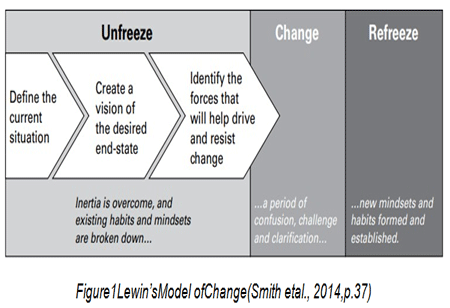
Change is constant, and it affects both organizations and individuals. Change can bring opportunities or disruptions, whether new technology, market shifts, or organizational restructuring. As a manager, understanding the change process and how people react to it is essential to managing change effectively.
This article explores the role of managers in avoiding and overcoming resistance to change. It also delves into the change management model, which can help you guide individuals and teams towards successfully adopting new initiatives.
Change Management Model
Lewin's three-stage model remains a popular framework for understanding how people go through change. It highlights three distinct phases: unfreezing, changing, and refreezing (as shown in Figure 1).
During the first stage of unfreezing, individuals become aware of the need for change and are motivated to take action (Smith et al., 2014, p. 37). The second stage, changing, involves making the necessary changes (Ralph Smith, 2014, p. 38). Finally, during the third stage of refreezing, individuals solidify their changes and integrate them into their daily lives (Smith et al., 2014, p. 38).
 According to Degnegaard (2010), organizations can successfully implement changeby following three stages (Degnegaard, 2010, p. 89). By doing so, they can encourage employees to a dopt new ways of working and effectively over comeany resistance to change. This framework emphasizes the significance of motivation and support in making changes stick.
According to Degnegaard (2010), organizations can successfully implement changeby following three stages (Degnegaard, 2010, p. 89). By doing so, they can encourage employees to a dopt new ways of working and effectively over comeany resistance to change. This framework emphasizes the significance of motivation and support in making changes stick.
While Lewin's change model has been a well-known approach to change management, it has faced criticisms for being too simplistic and linear (Burnes,2004). Critics argue that the three-step process may no longer be applicable intoday's continuously changing world. Moreover, the refreezing phase presupposes that individuals can quickly adjust to the new changes—that is not always realistic (Child,2015,p. 350).
Furthermore, Lewin's model overlooks the importance of transformational changes inmanaging change (Burnes, 2004). As a result, this model may not be the solesolution for complex transformations, and those considering using Lewin's model should over come these limitations.
Communication should be clear and concise, and should be delivered in a way that every employee can understand. It is also crucial to listen to employees' concerns and address them promptly to ensure a smoother transition.
Resistance of Change
Did you know that 70% of change program sfail to achieve the irgoals? According to Boris Ewenstein, this is often because employees resist the transition and management is unsupportive (Ewensteinetal., 2015).
However, why do people resist change? One of the key reasons is that they fear theunknown (Harrington &Voehl, 2016, p. 10). In addition, it can be daunting to trysome thing new and relinquish control (Kanter, 2012).
Furthermore, change can be stressful and challenging (Peters, 2012), making somefeel inferior or lacking the necessary skills (Smith et al., 2014, p. 117). Lastly, somemay prefer the status quo and resist any disruption to how things have always beendone (Kotter, 2012, p.5).
Change is often met with resistance, which is perceived negatively and needs to beovercome. However, resisting change can have some advantages for the changeprocess. Employees who resist change may do so because they recognize that theproposed change is unnecessary or unhelpful (Dianne Waddell, 1998, p. 544). Thisresistance can serve as a check on any harmful or unwanted ideas introduced duringthe change process (Waddell & Sohal, 1998). Managers can also use resistance toidentifypotentialproblemsandissues withthechange(Ford& Ford, 2010).By engaging with and addressing resistance, managers can turn it into a positive forcefor change, ensuring that only beneficial changes are implemented. Embracing resistance as a useful tool can make the change process smoother and more effective.
"Understanding the type of change required, assessing the organization’sreadiness for change, and evaluating the company's culture are essentialcomponents to consider."
Role of Managers in Management of Change
Managers play a crucial part in the success of any change initiative. They are responsible for translating policy into action and leading teams that must adapt their ways of workingto achieve the desire dout comes (Ionescuetal.,2014).
Their effectiveness in accomplishing these tasks can greatly impact the success of the change process. In order to achievesuccess, managers must clearly understand the goals of the change initiative and how it will benefit the organisation (Jonathan,2009). They must also be able to communicate this vision to their teams and inspire them to work collaboratively towards its attainment (Stobierski, 2020). Moreover, managers must be equipped to offer support and mentorship to their team membersas they navigate the challenges of implementing change (Anderson & Anderson,2010,p. 55).
Ultimately, the role of managers in change implementation cannot be overstated.They are critical components to success and must be able to effectively lead and guide the irteams to embrace change and work towards achieving desire doutcomes.
Approaches to address resistance
Clear and Frequent Communication: To effectively implement a change,managers must communicate with their team.This includes explaining the reasons for the change, what will happen during the process, and the benefitsthat the change will bring. Communication should be clear and concise, andshould be delivered in a way that every employee can understand. It is alsocrucial to listen to employees' concerns and address them promptly to ensureasmoother transition.
Conclusion
Change is an inevitable constant. Managing change effectively involves understanding how people react to it. One popular framework for managing changeis Lewin's three-stage model, while there is no one-size-fits-all method to changethat will work in all situations. Complex transformations may require additional solutions. Understanding the type of change required, assessing the organization’sreadiness for change, and evaluating the company's culture are essentialcomponents to consider. By carefully examining these factors, organizations canchoose a change approach that fits their specific needs and goals. Although resistance to change is inevitable, it can also serve as a check on harmful or unwanted ideas during the change process.
Managers play a critical role in effective change management. They mustunderstand the goals of the initiative, communicate the vision, and inspire teams toembrace the changes. Engaging employees in the change process and offering support and mentorship will help managers successfully implement change and achieve desired outcomes.
We use cookies to ensure you get the best experience on our website. Read more...